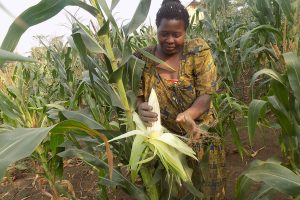
Unprecedented droughts have hit Uganda’s farmers hard in recent years, affecting household income and food security by drastically cutting maize yields, a staple crop in the country. In 2016, at least 1.3 million people in Uganda faced hunger and urgently needed food aid after a dry spell decimated harvests, leaving some with less than one meal per day. When MLN, a maize disease with the ability to cause extreme or complete crop loss in maize, arrived in Uganda in 2013, farmers needed a variety that could cope.
Enter, “bazooka,” a new maize variety that is giving hope to Ugandan farmers facing climate change-related drought and MLN.
Developed by Uganda’s National Crops Research Resources Institute (NaCRRI) and National Agricultural Research Organization (NARO) using traditional breeding methods and materials from the CGIAR Research Program on Maize (MAIZE) and the International Maize and Wheat Improvement Center (CIMMYT), bazooka maize has natural resistance to drought and MLN. Produced and distributed by the Naseco seed company, bazooka is gaining immense popularity in Uganda.
300 million people depend on maize as their main food source in sub-Saharan Africa, where many smallholder farmers do not have access to irrigation systems, and extended drought can be a death sentence for their crops. Now, with new drought tolerant varieties such as bazooka, they can expect better harvests.
To read the full story, please click here to view the original article from Seed World and CS Monitor.

 Climate adaptation and mitigation
Climate adaptation and mitigation